The History Of Cadillac
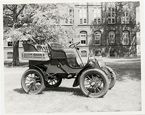
Cadillac is a brand of luxury vehicles owned by General Motors. Cadillac vehicles are officially sold in over 50 countries and territories, with the majority sold in the United States, Canada, and Mexico. In the mid-20th century, the name became a synonym for "high quality", used in such phrases as "the Cadillac of watches," referring to a Rolex. Cadillac's current slogan is Life. Liberty. And The Pursuit., in reference to the unalienable rights stressed in the United States Declaration of Independence.
Founding
Cadillac was formed from the remnants of the Henry Ford Company when Henry Ford departed along with several of his key partners and the company was dissolved. With the intent of liquidating the firm's assets, Ford's financial backers, William Murphy and Lemuel Bowen called in engineer Henry M. Leland of Leland & Faulconer Manufacturing Company to appraise the plant and equipment prior to selling them. Instead, Leland persuaded them to continue the automobile business using Leland's proven 1-cylinder engine. Henry Ford's departure required a new name, and on August 22, 1902, the company reformed as the Cadillac Automobile Company. Leland & Faulconer Manufacturing and the Cadillac Automobile Company merged in 1905.
The Cadillac automobile was named after the 17th century French explorer Antoine Laumet de La Mothe, sieur de Cadillac, who founded Detroit in 1701.
Contributions to the Automotive Industry
Cadillac helped to define advanced engineering, luxury and style early in automotive history and its vehicles would come to be known amongst the world's finest-made. Precision manufacturing of truly interchangeable parts was an award-winning industry first in 1908. Cadillac was the first manufacturer to release cars with a fully enclosed cab as factory equipment in 1910. In 1912, Cadillac was the first manufacturer to incorporate an electrical system that consisted of cranking, lighting and ignition. In 1915 they were the first to regulate engine cooling by thermostatic means, and in 1922 the first to introduce thermostatic control of engine carburetion. Cadillac was also the first to build inherent balance in the V-8 in 1923.
In 1912 Cadillac became the first manufacturer to offer an electric starter as standard equipment. It was developed by Charles Kettering and was marketed as a convenience device for female drivers. Anecdotally, Henry Leland insisted on this after a close friend was killed by a hand crank when his engine backfired[citation needed]. By allowing anyone to safely start a car, the electric starter ensured the dominance of the internal-combustion engine over steam or electric, even though the internal-combustion engine was not necessarily superior to steam in emissions, fuel economy, range, or performance at that time.
In July 1917, the United States Army needed a dependable staff car and they chose the Cadillac Type 55 Touring Model after exhaustive tests on the Mexican border. Several Cadillacs, used as testing platforms, passed the rigorous tests and as a result, 2,350 units of the Model 55 were supplied for use in France by officers of the American Expeditionary Force during WW I. Not one mechanical change was needed other than the requirement of khaki-brown paint.
Cadillac was the first manufacturer to utilize the skills of a designer to style a car's body instead of an engineer in 1927. It introduced shatter-resistant safety glass in 1926. In 1928, Cadillac's engineers were the first to design a fully-synchronized manual transmission using constant-mesh gears to prevent clashing upon executing a shift which increased drivability. Cadillac also introduced the 'Turret Top', the first all steel roof on a passenger car. Previously the center of the roof was made from leather covered wood. The Turret Top increased safety and was quieter. The marque was instrumental in the early development of the automatic transmission beginning in 1932; then in 1941, it became the first luxury car nameplate to offer an automatic transmission, GM's Hydra-Matic (introduced the previous year by sister division Oldsmobile).
For the 1914 model year Cadillac introduced the first production V8 engine. Also about this same time the MacManus advertising agency created the beautifully written "Penalty of Leadership", a one-time-only print ad which became a huge success. Cadillac salespeople requested copies for themselves as well as their customers, and the sales immediately increased. In 1945 (nearly thirty years after it ran), this ad was voted the best ad of all time by those in the industry. According to Advertising Age, this campaign is ranked 49th out of the top 100 ad campaigns of all time (Advertising Age 1998). Cadillac offered the first production V-16 engine (that included the world's first hydraulic valve lifters) from 1930 through 1940,as well as a V-12 from 1931 through 1937. Cadillac, along with Buick and Oldsmobile, introduced the production independent wishbone front suspension in 1934. The marque introduced tailfins for 1948. The Eldorado Brougham of 1957 offered the first instance of a 'memory seat' function, allowing seat positions to be saved and recalled for different drivers. The first fully automatic heater/ Air conditioning system was introduced in 1964. This system allowed the driver to set a desire temperature and the Climate Control maintained the temperature automatically. From the late 1960s onward, Cadillac offered a fiber-optic indication system which alerted the driver of a failed light bulb. Dual airbags were offered on some Cadillac models from 1974 to 1977.
Early vehicles
Their first car was completed in October 1902, the 10hp (7kW) Cadillac. It was practically identical to the 1903 Ford Model A. Many sources say the first car rolled out of the factory on October 17; in the book Henry Leland — Master of Precision, that date is shown to be October 20; another reliable source shows car #3 to have been built on October 16. In any case, the new Cadillac was shown at the New York Auto Show the following January, where it impressed the crowds enough to gather over two thousand firm orders. The Cadillac's biggest selling point was precision manufacturing and, therefore, reliability; it was simply a better made vehicle than its competition.
In February to March 1908, three Model K Cadillacs (1907 production) were released from the stock of Frederick Bennett (UK agent for Cadillac) at the Heddon Street showroom in London to compete in the annual Royal Automobile Club's Standardization Test. They were driven 25miles (40km) to the Brooklands race track at Weybridge where they completed another 25 miles (40 km) before being put under lock and key until Monday March 2, 1908 when they were released and disassembled completely. Their 721 component parts were scrambled in one heap; 89 parts requiring extreme accuracy were withdrawn from the heap, locked away at the Brooklands club house and replaced with new parts from the showroom stock. Using only wrenches and screwdrivers the 3 cars were re-assembled and on Friday March 13 they completed a mandatory 500 mile (800 km) run. On completion of the test, one of the cars was placed under lock and key where it remained until the start of the 2,000 miles (3,200 km) Reliability Trials, several months later. It came out the winner of the R.A.C. Trophy. Parts interchangeability could not have been proven in any other more appropriate way. As a result of these tests, the Cadillac Automobile Company was awarded the Dewar Trophy for 1908 (actual award date was February 1909). The Dewar Trophy was an annual award for the most important advancement of the year in the automobile industry.
Automobile stylist Harley Earl, whom Cadillac had recruited in 1926 and who was to head the new Art and Color section starting in January 1928, designed for 1927 a new, smaller "companion" car to the Cadillac which he called the La Salle, after another French explorer, René Robert Cavelier, Sieur de La Salle. That marque remained in production until 1940.
General Motors
Cadillac was purchased by the General Motors conglomerate in 1909.
Cadillac became General Motors' prestige division, devoted to the production of large luxury vehicles. The Cadillac line was also GM's default marque for "commercial chassis" institutional vehicles, such as limousines, ambulances, hearses, and funeral home flower cars, the latter three of which were custom built by aftermarket manufacturers. Cadillac does not produce any such vehicles in factory.
Pre-World War II Cadillacs were well-built, powerful, mass-produced luxury cars, aimed at an upper class market. In the 1930s, Cadillac added cars with V12 and V16 engines to their range, many of which were fitted with custom coach-built bodies; these engines were remarkable at the time for their ability to deliver a combination of high power, silky smoothness and quietness.
The Great Depression
In 1932, after Cadillac suffered from record low sales and charges of discrimination against black customers, Alfred Sloan created a committee to consider the discontinuation of the Cadillac line. At a fateful board meeting, Cadillac president Nicholas Dreystadt heard that legendary boxer Joe Louis could not go into a dealership to buy a car, because he was black, and resorted to having a white friend make the purchase for him. Dreystadt gave the GM Board of Directors a 10 minute speech in which he advocated advertising to black consumers so as to increase sales. The Board agreed to give Dreystadt 18 months to produce results. Cadillac managed to survive the Great Depression by being part of GM. By 1940, Cadillac sales had risen 10-fold compared to 1934.
The year 1934 brought about a revolution in assembly line technology. Henry F. Phillips introduced the Phillips screw and driver onto the market. He entered into talks with General Motors and convinced the Cadillac group that his new screws would speed assembly times and therefore increase profits. Cadillac was the first automaker to use the Phillips technology, which was widely adopted in 1940.
Postwar
Postwar Cadillacs, incorporating the ideas of General Motors styling chief Harley J. Earl, innovated many of the styling features that came to be synonymous with the classic (late 1940s-late 1950s) American automobile, including tailfins and wraparound windshields. Cadillac's first tailfins, inspired by the twin rudders of the Lockheed P-38 Lightning, appeared in 1948; the 1959 Cadillac was the epitome of the tailfin craze, with the most recognizable tailfins of any production automobile.
Cadillac's other styling attribute was its front bumper designs which became known as Dagmar bumpers or simply Dagmars. What had started out after the war as an artillery shell shaped bumper guard became an increasingly important part of Cadillac's complicated front grille and bumper assembly. As the 1950s wore on, the element was placed higher in the front end design, negating their purpose as bumper guards. They also became more pronounced and were likened to the bosom of 1950s television personality Dagmar. In 1957 the bumpers gained black rubber tips which only heightened the relationship between the styling element and a stylized, exaggerated bumper design. For 1958 the element was toned down and was completely absent on the 1959 models.
Low points, and recovery
Excessive dimensions
Despite record sales in 1973 and again in the late 1970s, Cadillac suffered from the malaise that set in to the American auto industry in the late 1970s to the late 1980s, primarily due to new government mandates on safety, emissions, and fuel economy. There were many high points, such as the launch of the front-wheel drive Eldorado in 1967 as a personal luxury coupe, with its simple, elegant design — a far cry from the tail-fin and chrome excesses of the 1950s. The 1970s saw vehicles memorable for excesses in dimensions and engine size before the downsizing era set in later in the decade. The new generation engine that debuted with the 1968 models at a displacement of 472cuin (7.7L) was designed for an ultimate capacity potential of 600cuin (9.8L). Displacement was increased to 500cuin (8.2L) for the 1970 model Eldorado, then adopted across all models for 1975 but performance waned after peaking at 420horsepower (310kW) and over 550foot-pounds force (750N·m) of torque in the first year and declined in 1971 and later years due to reductions in compression ratios necessitated by the advent of low-octane unleaded fuel and increasingly stringent emission requirements that further sapped performance and fuel economy.
Seville introduction and downsizing
The compact Seville was introduced in April 1975 as a 1976 model and came standard with the first electronic fuel injection system. The engine was a fuel-injected version of the Oldsmobile 350. The 1977 downsized full-sized cars and Eldorado, got a downsized 425cuin (7L) V8. This engine provided good performance and fuel economy for the downsized RWD models but was underpowered for the large Eldorado. The bore was further reduced for 1980-1981 to provide 368cuin (6L), again sharing the stroke of the original 472, as well as the weight and physical bulk.
As with most American brands, Cadillac was forced to downsize its offerings between the 1973 and 1979 fuel crises. Its staple De Ville and Fleetwood lines were downsized for 1977 and again for 1985 when the cars were also changed to a front-drive configuration. A downsized Eldorado debuted in 1979 with a new bustleback Seville sedan introduced on the same platform in 1980. Both the Eldorado and Seville were further downsized in 1986 into the compact car class, with sales also shrinking.
"Look-alike, drive-alike syndrome"
The "look-alike", "drive-alike" syndrome that affected most General Motors divisions under the administration of Roger Bonham Smith would have a negative effect on Cadillac as it tried to downsize its models. The Deville, a generally successful model for Cadillac, would receive a complete redesign in 1985 that made the car heavily resemble its platform mates, the Buick Electra and Oldsmobile 98.
Diesel V8
Due to gasoline shortages, Cadillac offered an Oldsmobile V8 engine that used diesel, the 'LF9' 350cuin (5.7L) unit, in its full-size cars from 1979 to 1985. Similar in appearance to the gasoline engines from which they were developed, they used much thicker and heavier castings, and a higher quality alloy was used for their block and heads. The main bearing journals were also increased to 3inches (76mm) to compensate for the higher operating stresses and pressures that diesel engines exert on their reciprocating parts. However, this engine gained a reputation for unreliability, mainly due to its inability to withstand the effects of the poor quality of the diesel fuel available at the time. The fuel system did not have an effective water separating system, and neither the buyers nor the dealer service staff were adequately informed about the products and procedures necessary for the proper maintenance of the engine. This led to corrosion in the fuel injection pump, leading in turn to incorrect injection cycles, cylinder head lift, stretching or breaking of cylinder head bolts, failure of head gaskets, hydro-lock from coolant leaking into the cylinder, and the breaking of engine components, thereby causing catastrophic engine failure. In the hands of an experienced diesel operator, these engines can (and often do) travel for hundreds of thousands of trouble free miles. However, for a society of people who just "gas and go", this engine was particularly ill suited to the task. Ironically, Detroit Diesel, another division of GM, had decades of experience building Diesel engines.
Cimarron
In an attempt to appeal to younger buyers, Cadillac launched the compact Cimarron in 1982. The Cimarron shared the J platform with the Chevrolet Cavalier, Buick Skyhawk, Oldsmobile Firenza, Pontiac J2000, Holden Camira, Isuzu Aska, and Opel Ascona, and was expected to rival the BMW 3-series[citation needed]. As the Cimarron was rushed to production about three years ahead of schedule, only a four-cylinder engine was available (a V6 arrived in 1985) and, at first, minimal styling differences were made to distinguish it from the considerably cheaper Chevrolet version. Buyers generally dismissed the Cimarron as a "warmed-over Cavalier" with leather seats. Styling became much more in tune with other Cadillacs in its later years, but sales did not significantly improve after its initial rejection and it was discontinued in 1988.
V8-6-4 and HT4100
[original research?]
Another nadir during the early 1980s was the variable displacement engine, branded the L62 V8-6-4 engine. Introduced in 1981, this 6L (368cuin) engine selectively activated and deactivated cylinders according to power demand. But it proved unreliable and was dropped the next year in favor of a family of smaller aluminum V8 engines rushed into production. The HT-4100 4.1L (≈250cuin) engine was used widely in Cadillacs from 1982 through 1987. The majority of HT4100's failed before 60,000miles (97,000km) and many of the 1,000,000 HT4100's installed in 1982-1987 Cadillacs were replaced by the factory under warranty although some motors went 200,000miles (320,000km) with extremely careful maintenance and no overheating episodes which this aluminum block engine does not tolerate. The HT4100's problems were far more serious and prevalent than those in the one-year only V8-6-4 and cost Cadillac the loyalty of many customers. Cadillac introduced the 4.5 liter aluminum v8 in 1988 which proved to be a very reliable motor, these motors often see well over 250,000miles (400,000km). This power plant was bumped up to 4.9 liters in 1991 and ran until 1993. The famous Northstar V8 would power the Eldorado from the 1992 model year through the next decade.
Allanté
1987 saw Cadillac try to rebuild its image, aware that imported European and Japanese performance models were on a rise, and with Honda launching its American luxury division, Acura. Some new design approaches were tried: the Seville, for instance, was downsized to BMW 5 series proportions and had rounded wheel arches with only a hint of chrome. During this period, the greatest challenge to the import sports cars was the Cadillac Allanté, a convertible designed by Pininfarina of Italy, and built on what was touted as the world's longest production line—with the car's bodies fabricated in Italy and flown by Boeing 747 to the United States to meet their transmission and engine.
In the initial two years of production, Cadillac offered no options for the Allanté except for the interior and body color. Like the Cimarron of a few years earlier, the Allanté was introduced with an engine which was below the expectations of its target market. The 170horsepower (130kW) HT-4100 engine was insufficient against more powerful competition. This introductory platform turned off many potential customers, who considered the vehicle to be underpowered for its $55,000 price tag, causing them to conclude that Cadillac was not genuinely committed to building a performance car. In 1989 the powertrain was improved with the 4.5L engine producing 200horsepower (150kW). Finally, in 1993 the powertrain was again upgraded to respectable performance with the 4.6L Northstar V8 producing 290horsepower (220kW). This turned out to be the final year of production, as Allanté sales never reached the volume which Cadillac hoped for.
Downsizing and the Brougham
The Cimarron and Seville models marked a beginning of "smaller" cars for the Cadillac line. Throughout the 1980s, American auto makers downsized most of their models, and Cadillac was no exception. By the late '80s, the Brougham was the only Cadillac model that retained the style and size of the "big" DeVilles and Fleetwoods of the '70s. The Brougham was redesigned in 1993 and renamed the Fleetwood, with an optional Brougham package,towing capacity is up to 7,000pounds (3,200kg) with the L05 V8. In 1994 Cadillac replaced the L05 engine with the new more powerful LT1 engine. The Fleetwood was discontinued after the 1996 model year. Following the demise of the Fleetwood, the Lincoln Town Car was left as the sole traditional full-sized luxury car remaining in the U.S. market.
Competition with Lincoln - Escalade
After GM phased out the D platform in 1996, Cadillac was left with a completely front-wheel drive lineup except for the European-based Catera, introduced for 1997. The GMC Yukon Denali-based Escalade, Cadillac's first sport utility vehicle, was introduced in 1998 for the 1999 model year, and featured standard all-wheel drive. It was quickly created to capitalize on the instant market success of the Lincoln Navigator launched as a 1998 model and seemingly destined to propel the Lincoln brand's sales total for the 1998 calendar year well ahead of Cadillac's. Had this happened, it would have been the first time Lincoln's sales total exceeded Cadillac's in the previous forty-eight years.
By November 1998, Lincoln's year-to-date lead was a comfortable 6,783 vehicles, but Cadillac's December sales were reported as 23,861 vehicles, more than 10,000 ahead of its November sales. A prominent proportion of this increase was a rise in Escalade sales from 960 in November to 3,642 in December. The result was an overall lead for the Cadillac brand by a slim 222 vehicles. Subsequent audits of sales records during the first quarter of 1999, prompted by the unusual numbers posted in December plus the fact that Escalade sales had dropped to a mere 225 vehicles in January 1999, resulted in the discovery of an "error" of 4,773 units. With this corrected, it meant that Lincoln had in fact passed Cadillac in total sales for the 1998 calendar year (187,121 Lincolns sold vs. 182,570 for Cadillac).
In the first week of May, 1999, a public retraction and apology was issued by GM spokesman Jim Farmer, admitting that "a combination of internal control breakdowns and overzealousness on the part of our team members" was the cause of the overstated figures, and adding that those responsible had been disciplined. However neither brand would have any reason to celebrate any sales success in the U.S. luxury market as their prior number-one and number-two positions had been overtaken by Japanese and German brands.
The Art and Science Era
Cadillac has resisted the trend toward to producing "retro" models such as the revived Ford Thunderbird or the VW New Beetle. It has instead pressed ahead with a new design philosophy for the 21st century called "art and science" which it says "incorporates sharp, shear forms and crisp edges — a form vocabulary that expresses bold, high-technology design and invokes the technology used to design it." This new design language spread from the original CTS across the line all the way up to the XLR roadster.
Electric vehicles
A hybrid electric version of the Escalade is now available. New York Giants football player Eli Manning was awarded the keys to the Cadillac Escalade hybrid at the end of the Super Bowl XLII.
Also the Cadillac Converj Concept was unveiled at the 2009 North American International Auto Show (NAIAS).
Historical and classic
- 1902-1903 Cadillac runabout and tonneau — 72in wheelbase single-cylinder engine
- 1903-1904 Cadillac Model A — 72in wheelbase single-cylinder engine
- 1904 Cadillac Models A and B
- Model A — 72in wheelbase single-cylinder engine
- Model B — 76in wheelbase single-cylinder engine
- 1905 Cadillac Models B, C, D, E and F
- Model B — 76in wheelbase single-cylinder engine
- Model C — 72in wheelbase single-cylinder engine
- Model D — 100in wheelbase four-cylinder engine
- Model E — 74in wheelbase single-cylinder engine
- Model F — 76in wheelbase single-cylinder engine
- 1906 Cadillac Models H, K, L, and M
- Model H — 102in wheelbase four-cylinder engine
- Model K — 74in wheelbase single-cylinder engine
- Model L — 110in wheelbase four-cylinder engine
- Model M — 76in wheelbase single-cylinder engine
- 1907 Cadillac Models G, H, K, and M
- Model G — 100in wheelbase four-cylinder engine
- Model H — 102in wheelbase four-cylinder engine
- Model K — 74in wheelbase single-cylinder engine
- Model M — 76in wheelbase single-cylinder engine
- 1908 Cadillac Models G, H, M, S and T
- Model G — 100in wheelbase four-cylinder engine
- Model H — 102in wheelbase four-cylinder engine
- Model M — 76in wheelbase single-cylinder engine
- Model S — 82in wheelbase single-cylinder engine
- Model T — 82in wheelbase single-cylinder engine
- 1909-1911 Cadillac Model Thirty
- 1909 — 106in wheelbase four-cylinder engine
- 1910 — 110in wheelbase; 120in wheelbase (limousine) four-cylinder engine Fisher
- 1911 — 116in wheelbase four-cylinder engine Fisher
- 1912 — Cadillac Model 1912; 116in wheelbase four-cylinder engine Fisher
- 1913 — Cadillac Model 1913; 120in wheelbase four-cylinder engine Fisher
- 1914 — Cadillac Model 1914; 120 and 134in wheelbase four-cylinder engine Fisher
- 1915 — Cadillac Type 51; 122 and 145in wheelbase V8 Fisher
- 1916 — Cadillac Type 53; 122 132 and 145in wheelbase V8 Fisher
- 1917 — Cadillac Type 55; 125 and 145in wheelbase V8 Fisher
- 1918-1919 Cadillac Type 57; 125 132 and 145in wheelbase V8 Fisher
- 1920-1921 Cadillac Type 59; 122 and 132in wheelbase V8 Fisher
- 1922-1923 Cadillac Type 61; 132in wheelbase V8 Fisher
- 1924 — Cadillac Type V-63; 132 and 145in wheelbase V8 Fisher
- 1925 — Cadillac Type V-63; 132 138 and 145in wheelbase V8 Fisher Fleetwood
- 1926-1927 Cadillac Series 314; 132 138 and 150in wheelbase V8 Fisher Fleetwood
- 1928 — Cadillac Series 341-A; 140 and 152in wheelbase V8 Fisher Fleetwood
- 1929 — Cadillac Series 341-B; 140 and 152in wheelbase V8 Fisher Fleetwood
- 1930 Cadillac Series 353, 370 and 452 Fisher Fleetwood
- Series 353 — 140 and 152in wheelbase V8 Fisher Fleetwood
- Series 370 — 140 143 and 152in wheelbase V12 Fisher Fleetwood
- Series 452 — 148in wheelbase V16 Fisher Fleetwood
- 1931 Cadillac Series 355, 370-A and 452-A Fisher Fleetwood
- Series 355 — 134 and 152in wheelbase V8 Fleetwood
- Series 370-A — 140 143 and 152in wheelbase V12 Fleetwood
- Series 452-A — 148in wheelbase V16 Fisher Fleetwood
- 1932 Cadillac Series 355-B, 370-B and 452-B Fisher Fleetwood
- Series 355-B — 134 and 156in wheelbase V8 Fisher Fleetwood
- Series 370-B — 140 and 156in wheelbase V12 Fisher Fleetwood
- Series 452-B — 143and 149in wheelbase V16 Fisher Fleetwood
- 1933 Cadillac Series 355-C, 370-C and 452-C Fisher Fleetwood
- Series 355-C — 140 and 156in wheelbase V8
- Series 370-C — 134 140 and 156in wheelbase V12
- Series 452-C — 143 and 149in wheelbase V16
- 1934 Cadillac Series 10, 20, 30 and 452-D Fisher Fleetwood
- Series 10 — 128in wheelbase V8
- Series 20 — 136in wheelbase V8
- Series 30 — 146in wheelbase V8
- Series 370-D — 146in wheelbase V12
- Series 452-D — 154in wheelbase V16
- 1935 Cadillac Series 10, 20, 30 and 452-D Fisher Fleetwood
- Series 10 — 128in wheelbase V8
- Series 20 — 136in wheelbase V8
- Series 30 — 146in wheelbase V8
- Series 370-D — 146and 160in wheelbase V12
- Series 452-D or 60 — 154in wheelbase V16
- 1936 Cadillac Series 36-60, 36-70, 36-75, 36-80, 36-85, 36-90 Fisher Fleetwood
- Series 36-60 — 121in wheelbase V8
- Series 36-70 — 131in wheelbase V8
- Series 36-75 — 138in wheelbase V8
- Series 36-80 — 131and 160in wheelbase V12
- Series 36-85 — 138in wheelbase V12
- Series 36-80 — 154in wheelbase V16
- 1937 Cadillac Series 36-60, 37-65, 37-70, 37-75, 37-85, 37-90 Fisher Fleetwood
- Series 37-60 — 124 and 160.75in wheelbase V8
- Series 37-65 — 131in wheelbase V8
- Series 37-70 — 131in wheelbase V8
- Series 37-75 — 138 and 156in wheelbase V8
- Series 37-85 — 138in wheelbase V12
- Series 37-80 — 154in wheelbase V16
- 1938 Cadillac Series 38-60, 38-60S, 38-65, 38-75, 38-90 Fisher Fleetwood
- Series 38-60 — 124 and 160in wheelbase V8
- Series 38-60S — 127in wheelbase V8
- Series 38-65 — 132 in wheelbase V8
- Series 38-75 — 141 and 160in wheelbase V8
- Series 38-90 — 141in wheelbase V16
- 1939 Cadillac Series 39-60S, 39-65, 39-75, 39-90 Fisher Fleetwood
- Series 39-60S — 127in wheelbase V8
- Series 39-61 — 126 and 162_in wheelbase V8
- Series 39-75 — 141 and 161_in wheelbase V8
- Series 39-90 — 141in wheelbase V16
- 1940 Cadillac Series 40-60S, 40-62, 40-72, 40-75, 40-90 Fisher Fleetwood
- Series 40-60S — 127in wheelbase V8
- Series 40-62 — 129in wheelbase V8
- Series 40-72 — 138 and 165_in wheelbase V8
- Series 40-75 — 141 and 161_in wheelbase V8
- Series 40-90 — 141in wheelbase V16
- 1941 Cadillac Series 41-60S, 41-61, 41-62, 41-63, 41-67, 41-75 Fisher Fleetwood
- Series 41-60S — 126in wheelbase V8
- Series 41-61 — 126in wheelbase V8
- Series 41-62 — 126 and 163in wheelbase V8
- Series 41-63 — 126in wheelbase V8
- Series 41-67 — 139in wheelbase V8
- Series 41-75 — 136 and 163in wheelbase V8
- 1942 Cadillac Series 42-60S, 42-61, 42-62, 42-63, 42-67, 42-75 Fisher Fleetwood
- Series 42-60S Fleetwood — 133in wheelbase V8
- Series 42-61 — 126in wheelbase V8
- Series 42-62 — 129in wheelbase V8
- Series 42-63 — 126in wheelbase V8
- Series 42-67 — 139in wheelbase V8
- Series 42-75 — 136 and 163in wheelbase V8
- 1946 Cadillac Series 60S, 61, 62, 75 Fisher Fleetwood
- Series 60S Fleetwood — 133in wheelbase V8
- Series 61 — 126in wheelbase V8
- Series 62 — 129in wheelbase V8
- Series 75 — 136in wheelbase V8
- 1947 Cadillac Series 60S, 61, 62, 75 Fisher Fleetwood
- Series 60S Fleetwood — 133in wheelbase V8
- Series 61 — 126in wheelbase V8
- Series 62 — 129in wheelbase V8
- Series 75 — 138in wheelbase V8
- 1948-1949 Cadillac Series 60S, 61, 62, 63, 75 Fisher Fleetwood
- Series 60S Fleetwood — 133in wheelbase V8
- Series 61 — 126in wheelbase V8
- Series 62 — 126in wheelbase V8
- Series 75 — 136in wheelbase V8
Finned Fifties
- 1950-1951 Cadillac Series 60S, 61, 62, 75 Fisher Fleetwood
- Series 60S Fleetwood — 130in wheelbase V8
- Series 61 — 122in wheelbase V8
- Series 62 — 126in wheelbase V8
- Series 75 — 146.75in wheelbase V8
- 1952 Cadillac Series 60S, 62, 75 Fisher Fleetwood
- Series 60S Fleetwood — 130in wheelbase V8
- Series 62 — 126in wheelbase V8
- Series 75 — 147in wheelbase V8
- 1953 Cadillac Series 60S, 62, 75 Fisher Fleetwood
- Series 60S Fleetwood — 130in wheelbase V8
- Series 62 — 126in wheelbase V8
- Series 75 — 146.75in wheelbase V8
- 1954-1955 Cadillac Series 60S, 62, 75 Fisher Fleetwood
- Series 60S Fleetwood — 133in wheelbase V8
- Series 62 — 129in wheelbase V8
- Series 75 — 149.8in wheelbase V8
- 1956 Cadillac Series 60S, 62, 75 Fisher Fleetwood
- Series 60S Fleetwood — 133in wheelbase V8
- Series 62 — 129in wheelbase V8
- Series 75 — 149.75in wheelbase V8
- 1957-1958 Cadillac Series 60S, 62, 70, 75 Fisher Fleetwood
- Series 60S Fleetwood — 133in wheelbase V8
- Series 62 — 129.5in wheelbase V8
- Series 70 — 126in wheelbase V8 "Eldorado Brougham"
- Series 75 — 149.7in wheelbase V8
- 1959-1960 Cadillac Series 60S, 62, 63, 64, 69, 75 Fisher Fleetwood
- Series 60S Fleetwood — 130in wheelbase V8
- Series 62 — 130in wheelbase V8
- Series 63 — 130in wheelbase V8"De Ville" sub-series
- Series 64 — 130in wheelbase V8"Eldorado" sub-series
- Series 69 — 130in wheelbase V8 "Eldorado Brougham"
- Series 75 — 149.75in wheelbase V8
1960's and 1970's
- 1961-1964 Cadillac Series 60S, 62, 75 Fisher Fleetwood
- Series 60S Fleetwood — 129.5in wheelbase V8
- Series 62 — 129.5in wheelbase V8
- Series 75 — 149.8in wheelbase V8
- 1965-1966 Cadillac "Calais", "De Ville" and "Fleetwood" Series Fisher Fleetwood
- Calais — 129.5in wheelbase V8
- DeVille/ Coupe de Ville — 129.5in wheelbase V8
- Fleetwood — 133 149.8 and 156in wheelbase V8
- 1967-1970 Cadillac "Calais", "De Ville" and "Fleetwood" Series Fisher Fleetwood
- Calais — 129.5in wheelbase V8
- DeVille/ Coupe de Ville — 129.5in wheelbase V8
- Fleetwood — 120 133 149.8 and 156in wheelbase V8
- 1970-1973 Cadillac "Calais", "De Ville" and "Fleetwood" Series Fisher Fleetwood
- Calais — 130in wheelbase V8
- DeVille/ Coupe de Ville — 130in wheelbase V8
- Fleetwood — 126.3 133 151.5 and 157.5in wheelbase V8
- 1974 — Cadillac "Calais", "De Ville" and "Fleetwood" Series Fisher Fleetwood
- Calais — 130in wheelbase V8
- DeVille/ Coupe de Ville — 130in wheelbase V8
- Fleetwood — 126 133 151.5 and 157.5in wheelbase V8
- 1975 — Cadillac "Calais", "De Ville", "Seville" and "Fleetwood" Series Fisher Fleetwood
- Calais — 130in wheelbase V8
- DeVille/ Coupe de Ville — 130in wheelbase V8
- Seville — 114.3in wheelbase V8
- Fleetwood — 126.3 133 151.5 and 157.5in wheelbase V8
Alphabetical model summary
- 1987-1993 Cadillac Allante
- 1985-1992 Cadillac Brougham
- 1965-1976 Cadillac Calais
- 1975-1976 Cadillac Castilian Station Wagon
- 1997-2001 Cadillac Catera
- 1982-1988 Cadillac Cimarron
- 1935-1983 Cadillac commercial chassis
- 1949-2005 Cadillac DeVille
- 1949-1993 Cadillac Coupe de Ville
- 1953-2002 Cadillac Eldorado
- 1956-1964 Cadillac Eldorado Biarritz
- 1957-1960 Cadillac Eldorado Brougham
- 1956-1960 Cadillac Eldorado Seville
- 1965-2003 Cadillac Fleetwood Eldorado
- 1927-1996 Cadillac Fleetwood
- 1975-2004 Cadillac Seville
- 1938-1993 Cadillac Sixty Special
- 2005-present Cadillac XLR-V
- 2005-present Cadillac STS-V
- 2004-present Cadillac CTS-V
- 2005-present Cadillac BLS (Europe, Middle East, Asia, Mexico, and South Africa only)
- 2003-present Cadillac CTS
- 2006-present Cadillac DTS
- 1999-present Cadillac Escalade full-sized SUV
- 2003-present Cadillac Escalade ESV top of the line SUV
- 2002-present Cadillac Escalade EXT pickup truck
- 2004-present Cadillac SRX
- 2005-present Cadillac STS
- 2004-present Cadillac XLR
- Cadillac V-16 Aero coupe — 1933
- Cadillac Caribbean, Coupe de Ville, El Rancho, Embassy — 1949
- Cadillac Debutante — 1950
- Cadillac custom roadster for Bill Boyer — 1951-52
- Cadillac Eldorado and Townsman — 1952
- Cadillac Le Mans and Orleans — 1953
- Cadillac El Camino, La Espada, Park Avenue — 1954
- Cadillac Celebrity, Eldorado Brougham, La Salle II, Eldorado St. Moritz, Westchester — 1955
- Cadillac Castilian, Gala, Maharani, Palomino, Eldorado Brougham and Eldorado Brougham Town Car — 1956
- Cadillac Director — 1957
- Cadillac "Rain Car" and 4-door Eldorado Seville — 1958
- Cadillac Cyclone — 1959
- Cadillac 4-door phaeton — 1960
- Cadillac Florentine — 1964
- Cadillac CART-PPG — 1985
- Cadillac Voyage — 1988
- Cadillac Solitaire — 1989
- Cadillac Aurora — 1990
- Cadillac Evoq — 1999
- Cadillac Vizon — 2000
- Cadillac Imaj — 2001
- Cadillac Cien — 2002
- Cadillac Sixteen — 2003
- Cadillac Provoq — 2008
- Cadillac CTS Coupe - 2008
- Cadillac Converj Concept (PHEV)- 2009
- Cadillac World Thorium Fuel (WTF)- 2009
Cadillac, licensing its name to Kent Bicycles, created a Cadillac Bicycles unit in 2005. GM aided Kent in the designing and furnishing of the premium, $400 to $1900 line of bikes, attempting to keep in mind Cadillac's tradition of quality and luxury. Some dealerships offered the bicycles as part of the purchase of a Cadillac automobile, and GM employees may receive a discount on the bikes. The division hopes to appeal to consumers who are brand-conscious and introduce a younger demographic to Cadillac.
From Wikipedia, the free encyclopedia
More About Cadillac
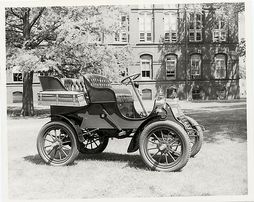
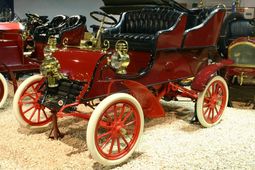
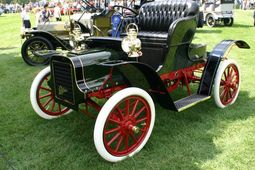
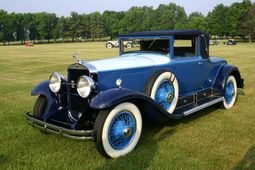
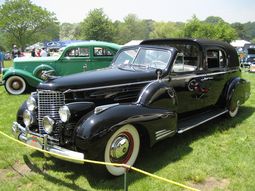


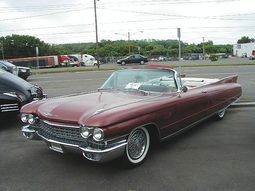
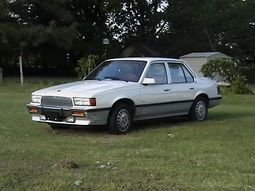
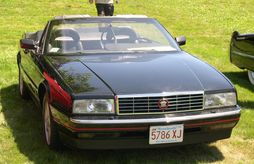
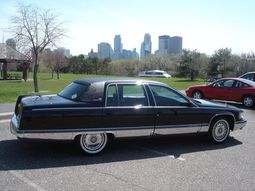
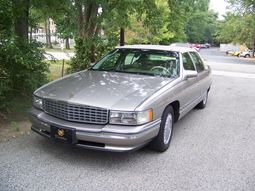
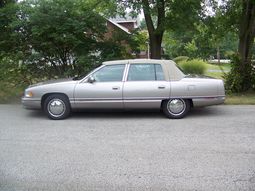
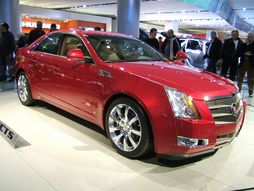
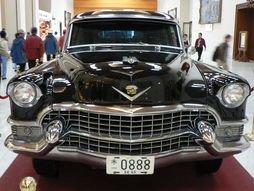

|